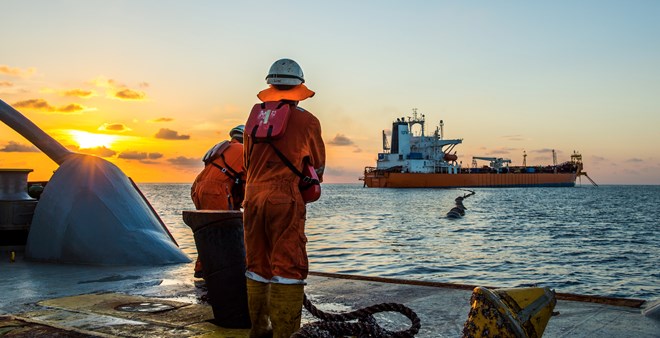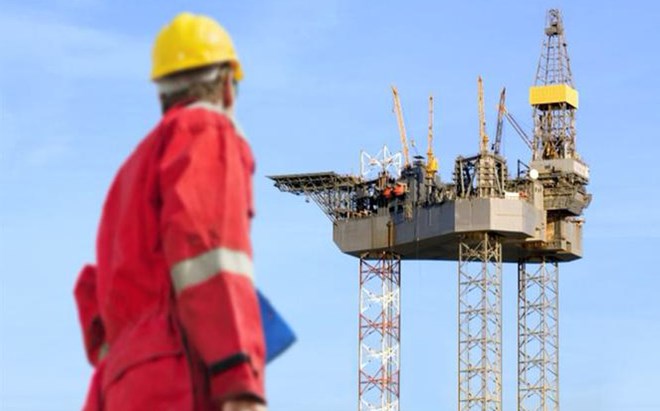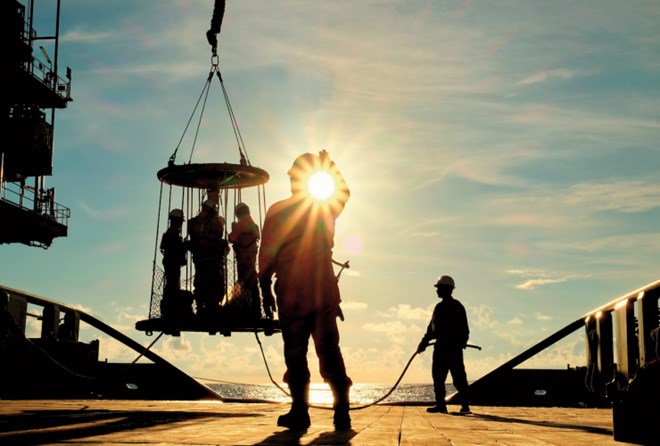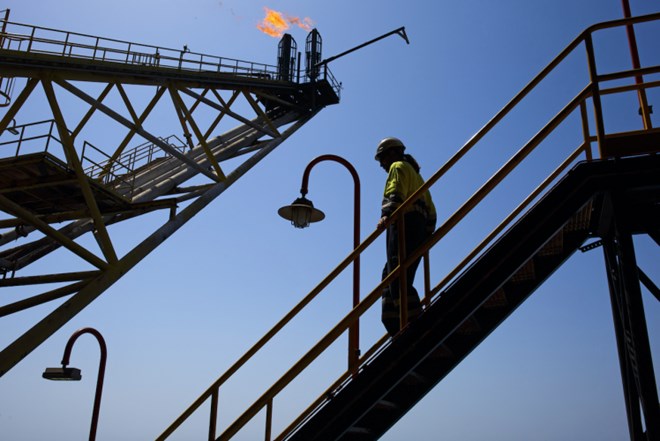African Business Magazine
Monday May 13, 2019
By Tom Collins

There have been substantial discoveries of oil and gas in East Africa and the Indian Ocean in the last decade, but the full potential of the region has yet to be realised, as Tom Collins reports.
When, in February, Somalia’s ambassador to Kenya found himself bundled aboard a direct flight to Mogadishu after hasty instruction from the Kenyan government, it was clear that the long-standing Indian Ocean border dispute between Kenyan and Somalia had reached a new low.
With both sides laying claim to a 100,000sq km triangle containing potential offshore oil and gas, the long-standing row – which was taken to the International Court of Justice (ICJ) in 2014 – was triggered once more after Kenya accused Somalia of auctioning off four contested blocks to bidders during a conference in London earlier this year.
While the Mogadishu government strongly denies this claim, Kenya’s foreign affairs principal secretary, Macharia Kamau, hit back by saying:
“This unparalleled affront and illegal grab at the resources of Kenya will not go unanswered and is tantamount to an act of aggression against the people of Kenya and their resources.”
As diplomats and ministers continue to trade blows, accusing one another of undermining national sovereignty and threatening regional stability, the standoff reminds the region of its lucrative hydrocarbon reserves and the high stakes involved in their exploitation.
Substantial discoveries made over the past decade have drawn the focus of large international oil companies (IOCs) – some of whom are beginning to produce at established sites along east Africa’s India Ocean seaboard – and have triggered the interest of a flurry of smaller exploration companies and eager parastatals looking to pioneer the next big find.
Africa’s Indian Ocean sits directly opposite the energy-hungry Asian markets of India, Southeast Asia and China.
With liquefied gas able to ship directly from source to port across the ocean, the positioning acts as a huge draw for investors looking to minimise their transport overheads and reach their Asian customer base.
With industry experts believing the relatively unexplored region may hold significant oil and gas reserves, the lucrative sector could fast-track development if governments are able to capture, realise and democratise the profits.
Ed Hobey-Hamsher, senior Africa analyst at global risk consultancy Verisk Maplecroft, argues that oil and gas potential in the region is vast.
“I don’t think anyone wants to be left behind,” he says.
“It’s not an easy place to do business but that certainly doesn’t mean that IOCs can afford to overlook it.”
Regional potential
Darren Woods, CEO of Texas-based ExxonMobil, the world’s largest publicly traded oil company, stunned industry observers last year when he announced plans to spend more than $200bn over the next seven years to increase his firm’s production of fossil fuels, along with investing in petrochemicals and refining.
This announcement came against a backdrop of modest capital expenditure in oil and gas by industry majors since the price of crude tanked in 2014.
As oil prices tentatively rebound, with Bank of America Merrill Lynch’s energy outlook for 2019 expecting Brent crude to settle at around $70 – although the risk of price volatility is high in the context of global trade disruptions – many IOCs are looking to ramp up output and increase profits.
ExxonMobil is banking on increased demand, despite global efforts to diversify the energy mix, and frontier markets like East Africa’s Indian Ocean will come to represent an ever-increasing share of industry portfolios, say analysts.
Two substantial discoveries over the last decade – gas in northern Mozambique and oil in Uganda – have directed the industry spotlight towards the East African and Indian Ocean regions, with many believing these finds are just the tip of the iceberg.
Italian oil major ENI along with US explorer Anadarko (which was acquired by Chevron in April for a total cost of $50bn) made a series of discoveries in Mozambique’s Rovuma Basin in 2010, in what was billed as the biggest natural gas find in recent decades.
With proven reserves of 100 trillion cubic feet (tcf), and resource estimates of 150 tcf, the Rovuma field holds enough gas to supply Germany, Britain, France and Italy for 15 years.
If these reserves are exploited effectively, experts predict that Mozambique could become the world’s third largest exporter of liquefied natural gas (LNG).
In 2006, Uganda discovered oil in the Albertine Rift Basin near its border with the Democratic Republic of Congo (DRC).
Reserves are estimated at 6bn barrels, with production expected to begin in 2022 and plateau at 230,000 barrels per day (bpd).
Although this pales in comparison with Nigeria’s capacity of 2.5m bpd, the ability of Uganda to kickstart production by partnering with large companies – in this case French major Total and China National Offshore Oil Corporation – is regarded as a prototype for the region.
Matthew Richmond, owner of Dar es Salaam-founded Samaki Consultants, believes the success or otherwise of these two projects will ultimately determine the overarching appetite for investment in oil and gas throughout the region.
“All eyes are on how it will work out with Uganda exporting their crude and how it will work out with Mozambique exporting their liquefied natural gas,” he says.
“Those are the two benchmarks on what happens in eastern Africa.”
After considerable industry to-ing and fro-ing following setbacks that include instability in the region and Mozambique’s hidden debt scandal, Maputo is awaiting final investment decisions (FIDs) from Anadarko and ExxonMobil – the two largest stakeholders in its gas fields – amounting to $20bn and $30bn respectively.

Workers
on a rig in Mozambique’s offshore Coral Field. The Coral natural gas
field located in Area 4, offshore Mozambique, is being developed by Eni
as the operator.
ExxonMobil’s Darren Woods has stated that the firm’s decision will be made later this year, as the company evaluates bids submitted by groups competing to build a pair of mega-liquefaction trains to liquefy gas in Mozambique’s north-eastern Cabo Delgado region – home to the Rovuma Basin.
Anadarko’s decision may come earlier, with chairman Al Walker saying they are “very close” after having secured a sales and purchase agreement (SPA) with India’s Bharat Petroleum Corporation, which has undertaken to purchase 1m tonnes per annum (tpa) of LNG for 15 years.
This brings the total number of locked-in gas sales to 8.5m tpa out of a 12.88m tpa capacity – a level Anadarko has previously said would allow it to make the investment.
Anadarko, an LNG and Africa novice, was forced to secure export destinations before it was able to secure finance and ultimately commit to the project.
ExxonMobil, with its large balance sheet and global network of buyers, along with extensive experience on the continent, is able to commit with far fewer stipulations from its partners.
While the FIDs signal the biggest steps yet towards unlocking Mozambique’s gas potential, Verisk Maplecroft’s Hobey-Hamsher emphasises that the two fields aren’t predicted to come online until 2024, meaning that stakeholders – particularly the Mozambican government – shouldn’t expect dividends anytime soon.
“If you talk to the government, they are still talking about LNG coming online in 2022 and that’s just not feasible,” he comments.
“We expect the fields to come online in 2024 but in terms of the government revenues that will be 2027.”
This, he argues, represents significant political risk for Mozambique as there are “massive discrepancies” between what the government is promising and what it will be able to deliver.
Other hindrances that continue to blight the country’s investment climate include the discovery of $2bn worth of hidden public debt in 2016, which saw the IMF cut funding and confidence in Mozambique plummet.
Al-Shabaab affiliated militants also continue to wreak havoc in Mozambique’s Cabo Delgado region, with an attack on Anadarko LNG infrastructure earlier this year resulting in the death of a company contractor.
Such political and security risks mirror issues in other resource-rich areas across the continent and are often the deciding factor in whether governments can capitalise on their natural wealth or not.
Bad investment climate
The Rovuma field extends into Tanzania, but the latter country’s political climate is retarding investment and activity in a sector with an estimated 55 tcf of gas reserves.
In many respects, Tanzania was first out of the blocks in terms of developing its gas fields, with the shallow offshore fields of Songo Songo and Mnazi Bay feeding gas into places including Dar es Salaam since the start of the millennium.
However, under the presidency of John Magufuli much of the foreign capital needed to continue developing resources has dried up.
Verisk Maplecroft’s 2019 Resource Nationalism Index puts the country in the “extreme risk” category.
In its crackdown on the extractive industries the government has hiked taxes, changed contracts and demanded stronger local content requirements.
While Tanzania should be commended for aiming to get more back from its latent wealth, the erratic and unilateral manner in which it has pursued these goals has strained ties with the business community.
In the energy sector, government talks with Norwegian firm Equinor have languished: the final investment decision on a $30bn onshore LNG export terminal still looks distant.
Richmond explains that much of the delay has been caused by tough demands from the Tanzanian government.
“In the past, if there was an issue with a contract it was arbitrated in an international court,” he says.
“Now Tanzania has said it has to be done in the local court – how do you think that will work out?”
While Mozambique, in contrast, has greater security and legacy issues, its government is more welcoming to foreign companies, which is reflected in the number of multinationals clamouring to do business there.

An oil worker passes the waste gas venting pipes on the Casablanca oil platform, operated by Repsol SA, in the Mediterranean Sea off the coast of Tarragona, Spain, June 28, 2016.
Mozambican President Filipe Nyusi recently announced plans to establish a sovereign wealth fund to govern gas revenue and focus spending on infrastructure development, poverty reduction and economic diversification, as well as protecting capital from corruption.
This mirrors Norway’s $1 trillion sovereign wealth fund, the largest in the world thanks to years of oil revenue, and suggests that Mozambique is at least nominally working towards effectively managing its gas sector.
Maputo is now set to launch its sixth licensing round in the second half of this year with Hobey-Hamsher predicting a full house.
“I expect all the major IOCs to be very interested in whatever acreage Mozambique makes available during that licensing round, should it go ahead,” he says.
Disputes in Somalia
In contrast with Mozambique’s progress, the spat between Somalia and Kenya playing out further up the coast only adds to Somalia’s long-standing difficulties in developing its significant offshore potential.
According to seismic surveys conducted by Spectrum Geo and Soma Oil and Gas, Somalia could hold as much as 100bn barrels worth of offshore potential.
Yet fortunes have gone from bad to worse as the government mismanages the sector and is repeatedly undermined by al-Shabaab attacks and the constant wrangling over authority with the autonomous regions of Puntland, Jubaland and Somaliland, the last of which has declared itself independent.
British company Soma Oil was one of the first energy explorers to enter Somalia in 2013, after nearly two decades of conflict.
The excitement abated after the company was accused of “appearing to fund systematic payoffs to senior ministerial officials” by a UN report and was investigated by the UK government’s Serious Fraud Office (SFO).
However, in 2016 the SFO concluded that there was “insufficient evidence to provide a realistic prospect of conviction”.
The conference in London earlier this year – which was organised by Spectrum Geo and the Somali government and led to Kenya’s allegations that Somalia was auctioning contested blocks – looks to have reignited activity in the sector.
Somalia promoted 15 new offshore blocks, including the four contested ones, with the government saying it will accept bids for exploration licences in November.
Industry remains sceptical
Industry insiders, however, are sceptical that any of the major players will take up Mogadishu’s offer despite the attractive offering presented in the geological surveys.
As President Mohamed Farmaajo’s government hurriedly works to push a new petroleum law through parliament and create a Somali Petroleum Agency from scratch, observers and opposition figures argue that Somalia does not have the institutional and regulatory capacity to handle large oil deals.
In this context, making a deal with the Somali government looks all too risky for many in the private sector.
Hakim Abdi, postdoctoral researcher at Lund University, believes any contracts the government signs will be vulnerable to corruption.
“I am afraid that the government will siphon off the money and leave nothing for the development of the country and the enhancement of its citizens,” he says.
Any funds accrued from oil development may also serve to further destabilise the already shaky relationships between Mogadishu and its regional detractors, he adds.
“There is already wrangling over authority, and who controls where; imagine what will happen if there is oil money involved,” he comments.
The dispute with Kenya adds to fears that oil will threaten regional stability as the Horn witnesses the souring of a relationship which is key to keeping al-Shabaab at bay.
The withdrawal of the Kenyan Defence Forces from a military base in Somalia, although not directly linked to the oil discord, speaks of strained relations between Nairobi and Mogadishu that could do without the complications of resource tussling.
As it stands, Somalia is hoping that the ICJ will award it the blocks, whereas Kenya would prefer a bilateral settlement that would involve some form of compromise.
Silas Olan’g, Africa co-director at the National Resource Governance Institute, an independent think tank, believes that if the court sides with Somalia, it may cause a domino effect to ripple down the Indian Ocean as other nations seek to redefine their maritime borders for strategic interest.
Comoros promise
Most of the large oil and gas finds thus far have hugged east Africa’s coastline, meaning that maritime borders – extending 200 miles (321km) according to the United Nations Law of the Sea – are extremely important in ownership disputes.
Outside this limit, the Indian Ocean gives way to a number of tiny African island nations that have been at the centre of much speculation and exploration since the gas bonanza in Mozambique.
Sitting just 300km opposite Mozambique’s Cabo Delgado region and its lucrative gas fields, the Comoro Islands are perhaps the next in line for a major discovery.
According to initial data from London-based exploration firm Discover Exploration, the archipelago – with a population of just 850,000 – could be sitting on as much as 7bn barrels of oil and 1.1 tcf of associated gas.
To put this into perspective, the US has 36.5bn barrels worth of oil according to 2017 data from the CIA World Factbook – only around five times more than the Comoros.
However, proven reserves and estimated resources are two very different things, meaning interest in three offshore blocks by Discover Exploration, which is leading the Comoros push, is a speculative undertaking.
“It’s a very undeveloped part of the world despite the fact that it’s very close to big discoveries in Mozambique,” says COO Alexander Mollinger.
“It is very risky and we as the contractors take all the financial risk; but we see that there is huge potential.”
British firm Tullow Oil, with a relatively large footprint across Africa, has partnered with Discover Exploration to conduct a 3D seismic survey of the area in the third quarter of 2019, depending on government approval.
The public sector, in fact, has been relatively quick to act, with Mollinger describing how the government managed to create a petroleum bill and push it through the Comoros assembly in just six months after Discover Exploration first made contact in 2012.
At the same time, political instability surrounding an election in which President Azali Assoumani controversially claimed over 60% of the vote – despite opposition claims of fraud and observer reports of irregularities – have threatened to spark unrest in the coming months.
Analysis from the African Energy consultancy group states that while private sector interest from UAE, Chinese, French and Italian energy entities has spiked in the past few years “all bets are off should political instability descend into a full-blown crisis”.
Operating in a volatile environment, and with no guarantee of making a discovery, Mollinger explains how companies such as his account for risk by spreading it over a large portfolio of similar assets.
Discover Exploration, for instance, has similar projects in Gabon and New Zealand along with a low-return low-risk project in the North Sea.
If one asset strikes black gold, the operational costs of the rest are covered as production begins to generate income.
The Comoro Islands and the surrounding region, however, are perhaps the most compelling area due to their strategic positioning in relation to neighbouring markets.
“It’s a direct line to the energy-hungry Asian markets,” he says. “It’s literally a straight line and you don’t have to pass through major conflict areas which exist around the Suez Canal.”
Prospects in Seychelles
Elsewhere in the Indian Ocean, the Seychelles is one of Africa’s most remote island nations – located around 1,800 km east of the Kenyan port of Mombasa.
Although the subject of less industry speculation, the tectonic history of the 115 islands making up the archipelago presents a strong case for the future of oil and gas finds, says Patrick Samson, exploration manager at national oil company Petro Seychelles.
Currently the government has four wells and is still in the early phases after creating what Samson calls the most attractive “benchmark” petroleum legislation for the region in 2013.
Sub-Sahara Resources, an Australian firm, has recently moved into the area and is looking to get lucky after the Japanese National Oil Company left last year. Indeed, Samson points out how the government is experiencing heightened interest and numerous survey requests since the Indian Ocean region has come into the fore.
Further south, the Seychelles government is partnering with Mauritius to explore areas located outside the maritime boundaries of both nations, with the dividends of any discovery to be shared equally among both parties.
This partnership stands in direct contrast to the dispute between Kenya and Somalia, and the collaboration – through the combining of funds and the sharing of best practice in terms of governance and legislation – will help unlock any potential in the region.
As Aly-Khan Satchu, CEO of Nairobi-based investment advisory firm Rich Management, says:
“The East African seaboard is the last great energy prize going.”